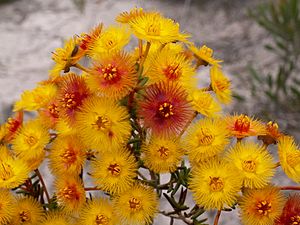Verticordia endlicheriana facts for kids
Quick facts for kids Verticordia endlicheriana |
|
|---|---|
 |
|
| V. endlicheriana var. manicula growing near Mount Lesueur | |
| Scientific classification | |
| Genus: |
Verticordia
|
| Species: |
endlicheriana
|
Verticordia endlicheriana is a beautiful flowering plant that belongs to the myrtle family, called Myrtaceae. You can only find this plant growing naturally in the south-west part of Western Australia. It's a type of bush, or shrub, with thin leaves. Its flowers are usually yellow, but some kinds can turn red as they get older. This plant is quite varied, and a scientist named Alex George officially described five different types, or varieties, of it in 1991.
Contents
What Verticordia endlicheriana Looks Like
Verticordia endlicheriana is a shrub that can grow up to about 1 m (3 ft) tall. It usually has one or more main stems coming from its base. The leaves on its stems are long and thin. They are shaped like a dish or are almost round when you look at them from the side. These leaves are about 2–4 mm (0.08–0.2 in) long and have a pointy tip. The leaves closer to the flowers are more oval or almost round. They are also about 2–4 mm (0.08–0.2 in) long.
The Flowers of Verticordia endlicheriana
The flowers of Verticordia endlicheriana sometimes have a nice smell. They grow in round clusters or groups that look like a corymb. These flower groups are on straight stalks that are 5–12 mm (0.2–0.5 in) long. The floral cup is shaped like a wide top. It is about 0.5–1.5 mm (0.02–0.06 in) long, has ribs, and is smooth (meaning it has no hairs).
The sepals, which are like small leaves that protect the flower bud, are yellow. In some types, they turn red as they get older. They are 3–4 mm (0.1–0.2 in) long and have 6 to 8 hairy parts called lobes. The petals are the same color as the sepals. They are 2.5–4.5 mm (0.1–0.2 in) long and have long, pointy parts that look like fingers. The style, which is part of the flower's reproductive system, is 1.5–2.5 mm (0.06–0.1 in) long, straight, and smooth. The time when these plants flower can be different for each variety.
Naming and Classification of Verticordia endlicheriana
The plant Verticordia endlicheriana was first officially described by a scientist named Johannes Conrad Schauer in 1844. His description was published in a book called Plantae Preissianae by Johann Georg Christian Lehmann. The first example of this plant, called the type specimen, was found by Ludwig Preiss near Cape Riche. The second part of its scientific name, endlicheriana, honors another botanist named Stephan Endlicher.
Different Varieties of Verticordia endlicheriana
In 1991, a scientist named Alex George studied the Verticordia group of plants very closely. He identified and described five different types, or varieties, of Verticordia endlicheriana:
- Verticordia endlicheriana var. endlicheriana: This variety has leaves near the flowers that are egg-shaped to almost round. They are 2–4 mm (0.08–0.2 in) long. Its sepals are 3–3.5 mm (0.12–0.14 in) long, and its petals are 3.5–4 mm (0.1–0.2 in) long. The flowers do not smell, but they turn red as they get older.
- Verticordia endlicheriana var. angustifolia: This type is similar to var. endlicheriana, but its leaves near the flowers are long and thin, measuring 4–8 mm (0.2–0.3 in).
- Verticordia endlicheriana var. compacta: This variety is also similar to var. endlicheriana, but its flowers do have a scent, and they do not turn red as they age.
- Verticordia endlicheriana var. major: This variety has longer sepals (3.5–4 mm (0.1–0.2 in)) and petals (3.8–4.5 mm (0.1–0.2 in)) compared to the other varieties.
- Verticordia endlicheriana var. manicula: This type is similar to var. compacta, but it grows in a more open, less dense way.
Alex George grouped this species into a larger category called subgenus Chrysoma. It is also part of a section within that subgenus, also called Chrysoma. Other plants in this section include V. citrella, V. subulata, and V. acerosa.
Where Verticordia endlicheriana Grows
This type of verticordia plant can be found in many different kinds of soils and plant communities. It grows in the south-west region of Western Australia. Each of the different varieties has slightly different needs for where it likes to grow.
Protecting Verticordia endlicheriana
The variety angustifolia is listed as "Priority Three". This means that we don't know a lot about it, and it's only found in a few places. However, it's not in immediate danger of disappearing. The other four varieties are not considered to be threatened.
Growing Verticordia endlicheriana in Gardens
The varieties endlicheriana and angustifolia are quite common in gardens. However, the other varieties have been harder for people to grow and keep alive in their gardens.

